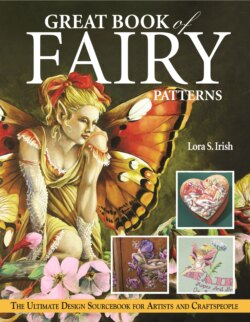Читать книгу Great Book of Fairy Patterns - Lora S. Irish - Страница 16
На сайте Литреса книга снята с продажи.
Оглавление8
G
REAT
B
OOK
OF
F
AIRY
P
ATTERNS
The oldest lore, circa 1100–1800
The best place to start any endeavor usually is
at the beginning, so let’s take a look at the earliest
recorded Fairy stories. Some of the oldest tales
directly referring to a race or species of small
human-like beings called Fairies date back to the
1100s in the British Isles. Often these tales were
passed down by word of mouth through the gen-
erations as families gathered in the evenings by
the fire. A grandfather or aged uncle could mes-
merize even the littlest in the house with stories of
magical people who brought rewards to the wor-
thy, meted out punishment to those that erred
into sinful ways, and caused unexplainable occur-
rences in the daily lives of man. Over the centu-
ries these tales were used as a way to record
notable events in the community as well as to
entertain.
The descriptions these tales give for Fairies are
wide and change often depending on the story,
the land in which the story first appeared and the
time period. But general guidelines can be found.
Fairies have light hair the color of golden,
dried wheat or strawberry red locks with tight
ringlets surrounding their faces. Bright, laughing
blue eyes often accent their rosy, red cheeks.
However, Fairies also can be dark and sultry, full of
mischief and revenge, with black, straight hair sur-
rounding a craggy face with deep-set, dark eyes.
The stories are clear in regards to Fairies’
statures. They do not stand very tall, usually
smaller than a toddler of two years down to the
size of a man’s thumb. Yet even with their diminu-
tive size, Fairy maidens were sought after as wives
for young men because of their alluring beauty
and sweet voice. The small size seems to change
when, on the night of a Fairy child’s birth, the
Fairy father rides up to the house of the local
human midwife on a full-sized horse, large enough
to carry both of them back to the palace to help
deliver the baby. Usually this same Fairy father
would be seen riding greyhounds that were spe-
cially bred for this purpose, not horses.
Colors abound when we read the old legends.
A Fairy might be dressed in rags or in a queenly
gown. Men were said to wear jackets of red and
green. The ladies seem to have a fondness for
brightly colored petticoats. Vibrantly colored
clothing seems to be one constant in Fairy tales,
except when it is time for a Fairy princess to give
birth. At that moment the tales clearly state that
she is dressed in a shade of white so pure it shim-
mers with opulence and that all who attend her
are dressed in the same manner.
The singing voice of a Fairy is magical and can
lure an unsuspecting man deep into the Fairy
rings of dance where he is destined to dance for
years and years. Lulled by the captivating tunes,
the mortal man feels his troubles and fears seem-
ingly disappear, which eases him through the day’s
toils or compels him to follow the beautiful voice
into unexpected adventures.
Fairies seem to be shy and elusive, yet when
they are seen they can change the life of any
human. A poor and starving farmer who grants just
a tiny favor to a Fairy can find he now is gifted a
magical cow that gives so much milk it fills every
pail offered. A man who bears the weight of the
world on his shoulders and responsibilities far
beyond his means because of a lazy and demanding
wife can find himself rescued to a Fairy palace of
wealth and luxury. For the courtesy of a pan of
warm water for bathing, a small pile of straw by the
hearth for sleeping and a bit of bread crumbs for
eating, a Fairy will leave an old woman’s home spar-
kling clean with a small silver coin on her table.
Fairies, however, are not above mischief and
revenge. A Fairy will cast a spell upon the coin
that she leaves on the hearth, so if the old woman
ever tells of the Fairy’s visit, the coin will turn to
black dust. If you anger a Fairy, you could find that
your favored daughter is lured into a Fairy palace,
destined to be held as a captive until her wedding
day is years past. One little vixen was especially
known for letting the cattle out of their stalls just
so she could hear the animals’ wondrous
cowbells ring when they walked.
